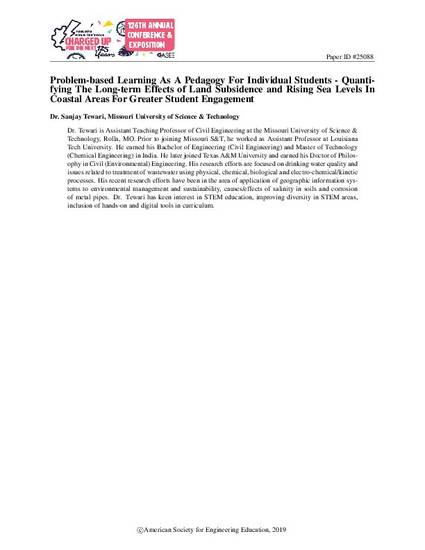
Course-based class discussions usually are limited to course syllabus and topics of lectures. If a discussion goes beyond course syllabus and the topics, usually there is a time constraint of class/lab periods, keeping educators and students from going deeper. Even without time constraints of class/lab settings, some students get engaged in the overall learning process more when they are challenged or tasked to solve a problem. This paper focuses on the pedagogical aspect of problem-based learning and its application for greater engagement of these students in quantifying the long term effects of land subsidence and rising sea levels in coastal or littoral areas.
The effects of rising in sea levels get complicated over time when land subsidence is also considered. This is especially true when students are tasked to project the effect of combined effects over a long duration in future and create spatial layers of water inundation marking areas that will be under water in next couple of decades. The task was made even more challenging because it needed real data from government websites and it needed to be downloaded, processed, transformed and interpolated before it was used in a way that would result in a meaningful projection of seawater inundation over coastal land. It is hard to recruit students for this kind of learning unless it is a class or term project.
Not many students usually take on for this kind of challenge to gain a better understanding of the concept and learn needed skills. However, if a spark of curiosity is provided, the task of recruiting gets easier this kind of non-course based but relevant learning. This kind of learning gets even more challenging when the student is a non-traditional undergraduate student. Cross (1980) defined the nontraditional student as an adult who returns to school full- or part-time while maintaining responsibilities such as employment, family, and other responsibilities of adult life. These students also may be referred to as "adult students," "re-entry students," "returning students," and "adult learners." This paper outlines the author’s experience in challenging a non-traditional student for problem-based learning. It also provides a detailed methodology that was followed by the student under author’s supervision and guidance for quantifying the long term effects of land subsidence and rising sea levels in coastal areas using data available at various government websites and Geographic Information System as a tool.
Available at: http://works.bepress.com/sanjay-tewari/27/
